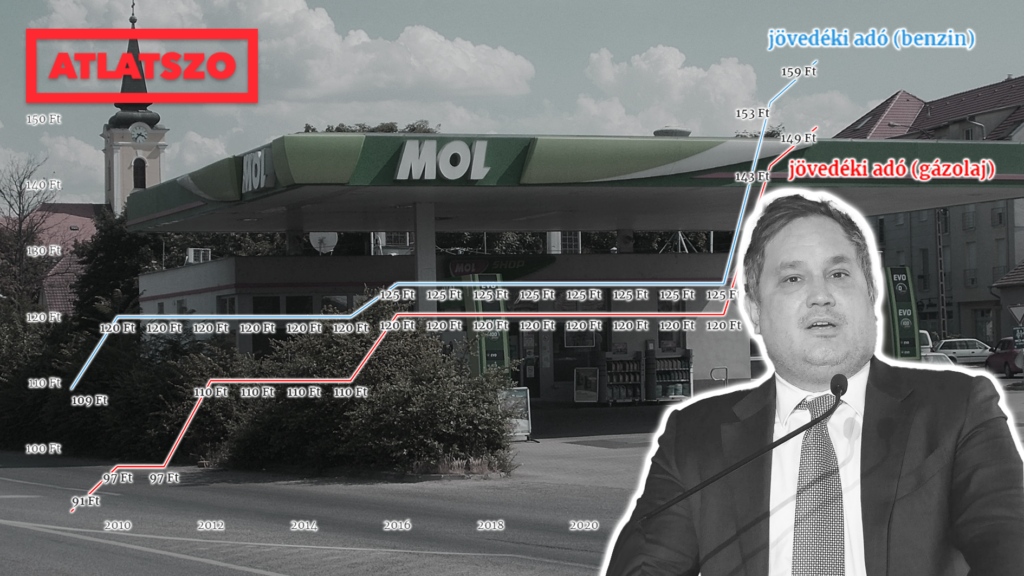The https://english.atlatszo.hu use cookies to track and profile customers such as action tags and pixel tracking on our website to assist our marketing. On our website we use technical, analytical, marketing and preference cookies. These are necessary for our site to work properly and to give us inforamation about how our site is used. See Cookies Policy
Fidesz oversees 30 percent increase on tax on fuel in last 10 years
There was a time, hard as it may be to believe, that Fidesz was in opposition – relentlessly vocal, but in opposition, nonetheless. Before 2010, the party had – often rightfully – advocated for a host of changes. One battle they fought was to reduce the fuel tax. The problem is, once in government, the party actually increased it.
Today, the excise tax on fuel is above the EU minimum, in addition to VAT, the retail surtax, and the energy efficiency contribution. A litre of gasoline now costs 640 forints – of this, 321 forints is taxes. The government has pointed accusatory fingers at chief nemesis Brussels, who have little to do with setting domestic tax rates and are likely more occupied with countries that are relevant on the global scale.

“If we are not prepared for it, the euro will kill our economy,” Viktor Orbán warned in recent days, explaining why Hungary is still not part of the Eurozone. Clearly, we are smarter than countries like France (GDP per capita twice that of Hungary’s), or Germany (GDP per capita 2.4 times that of Hungary’s), or even Croatia, where the economy received a notable boost when they adopted the currency.
Of course, there are advantages in resisting the common European currency. For one, the government needs to fulfil none of the prerequisite conditions.
Blame Ukraine, not us
Viktor Orbán spoke about fuel prices at the central bank’s conference at the end of January. “What is happening at Hungarian gas stations right now is outrageous, perhaps even infuriating,” said the Prime Minister.
The Ministry of National Economy explained: “The Ukrainian threat to oil supply and U.S. sanctions together are leading to a significant increase in fuel prices.” The ministry also stated that “China and India, as the world’s largest oil-importing nations, must source more crude oil from other sources, such as the Middle East, Africa, or even the American continent. This further increases raw material prices and raises transportation costs as well.”
Four factors determine fuel prices:
- The price of crude oil,
- Refining costs and profit,
- Distribution and marketing costs and profit,
- Taxes.
The Hungarian government highlighted only two of these factors but failed to mention the impact of its own taxation policy.
They also stayed quiet on the price of crude oil. The price of American oil, WTI, was $120 per barrel in June 2022, when 1 USD was 370 forints. This means that one barrel of oil cost 44,400 forints at the time.
In January 2025, the price of oil is $74 per litre, with the dollar at 391 forints, meaning that one barrel of oil costs 28,934 forints – significantly cheaper than in 2022.
And yet – as we roll up to fill up our tanks, the drop in crude oil prices is hardly felt. According to fuel prices reported by the National Tax and Customs Administration (NAV), there was a price cap in the summer of 2022, with gasoline sold for 480 forints per litre—while the market price was 684 forints. Currently, gasoline costs 633 forints and diesel 647 forints at gas stations.
To see how little the oil price—and the government’s explanation— determines fuel prices, let’s look at what happened when the price of oil was zero dollars per barrel.
In April 2020, during the coronavirus pandemic, the price of WTI fell to zero dollars. In fact, there were times when oil had a negative price. Despite this, at Hungarian gas stations, gasoline cost 388 forints in April 2020 and 293 forints in June. In December, this increased to 364 forints, while the price of oil rose to $49 per barrel and the exchange rate of the dollar changed to 296 forints.
Reduce the fuel tax, they said. It’ll be good, they said.
After the government essentially ran on tax reductions, any increase is taboo – in rhetoric. In exercise, according to the excise tax data from the NAV, last year, the excise tax on one litre of gasoline was 159 forints, while for diesel, it was 149 forints per litre, collected by the state.
Fuel prices are also subject to a 27% VAT, meaning taxation is applied twice. The graph clearly shows that the Fidesz government has increased the excise tax by nearly 30% in recent years, which has naturally contributed to rising fuel prices (blue: excise taxes on petrol, red: excise taxes on diesel).
Between 2002 and 2010, when Fidesz was in opposition, they demanded immediate fuel tax and VAT cuts from the then-ruling MSZP government hundreds of times in an era of austerity. After coming to power in 2010, the right-wing party’s stance on the issue has shifted, and they began raising the so-called “fuel tax.”
Plan B: blame Brussels
In the summer of 2023, András Tállai, then-Parliamentary State Secretary of the Ministry of Finance, claimed: “Brussels has been requesting for years that Hungary raise its excise tax level, which is below the EU standard. Therefore, under pressure from Brussels, we will adjust it to the EU minimum level next year.”
He failed to mention that, by this time, a Hungarian intervention had already been in place for two years, imposing an extra excise tax when oil prices were too low.
The chart below shows how excise taxes on petrol and diesel compare in the region (from top to bottom: Germany, Czechia, Slovakia, Austria, Hungary, Poland).
Fuel excise taxes are higher in the Czech Republic and Slovakia than in Hungary, while in Poland, they are close to the EU minimum. The graph shows that Hungary’s excise tax, measured in euros, decreased until 2023 and then increased in 2024.
In the same period in Austria and Slovakia, which use the euro, excise taxes did not change, and in Germany, they decreased last year. Meanwhile, in Poland and the Czech Republic—both, like Hungary, non-eurozone countries—taxes only increased slightly.
Umm, according to our calculations – the EU is clearly the independent variable in this causal relationship. Something else must be causing the rise in prices – and aha! Could it be, have we found it?
It is perhaps the government’s Europhobia – which has seen years and years of a policy of forint devaluation.
The declining excise tax in euro terms was simply a result of the weakening forint. This is why the government raised the tax last year.
In fact, by 2025, Hungary’s excise tax has surpassed the EU minimum. Once again, this was not something Brussels forced the government to do.
The European Commission, which defines common European taxes, told Átlátszó that “the Energy Taxation Directive (Council Directive 2003/96/EC) sets minimum tax rates in euros (€) that member states must apply to the energy products and electricity listed in the directive.” They also stated that non-eurozone member states must review their tax rates once a year in their own currency.
According to the European Commission’s taxation website, the current EU minimum tax rates are:
- Diesel: €0.33 per litre
- Gasoline: €0.359 per litre
However, Hungary’s tax rate is €0.39 per litre, meaning that Fidesz taxes fuel more than the required minimum.
Hungary’s excise tax would be even higher in euro terms if the forint strengthened. Worry not – this seems unlikely anytime soon.
We asked the Ministry of National Economy how many times and with what reasons the government has raised fuel taxes or imposed additional fees, but they did not respond.
We also asked MOL what they believe influences fuel prices the most and how it is possible that, despite much higher oil prices in 2022, market prices were only slightly higher than they are now. The company stated that, in line with corporate policy, they do not comment on prices.
The Hungarian Mineral Oil Association suggested that instead of NAV’s fuel prices, we should look at those from MEKH. We did, and according to the database, gasoline cost 490 forints per litre in 2022. This still doesn’t explain why, when oil was much more expensive, fuel prices were lower.
Ottó Grád, the association’s secretary-general, noted that seasonality plays a role: gasoline is more expensive in the summer, while diesel is pricier in other periods. He also reminded us that in 2022, sanctions affected Russian raw materials used in diesel production. Finally, he mentioned taxation as a key factor.
Retail Tax and Stockpiling Fee Incoming?
Energy expert Attila Holoda told Átlátszó that fuel prices in Hungary are not just affected by excise tax and VAT. There are additional levies, such as the special retail tax, which was 0.15% in 2023 but has now increased to 3%.
The EKR (Energy Efficiency Contribution) adds another 8.5 forints per litre. Breaking down the 659-forint diesel price:
- 236 forints account for the diesel itself,
- 106 forints cover wholesale and retail margins,
- Nearly 316 forints come from taxes.
In Hungary, the price is of a litre of gasoline stands at €1.58. By contrast, in the Czech Republic, where excise tax on fuel is 35% higher than in Hungary, a litre of gasoline costs €1.46. In Poland, where tax levels are the same as in Hungary, a litre of gasoline costs €1.507.
Written by Csaba Segesvári, data visualization by Krisztián Szabó, translation by Vanda Mayer. The Hungarian version of this story is here. Data source: Arcanum archives.

